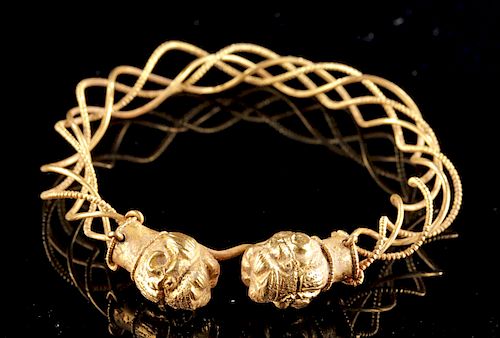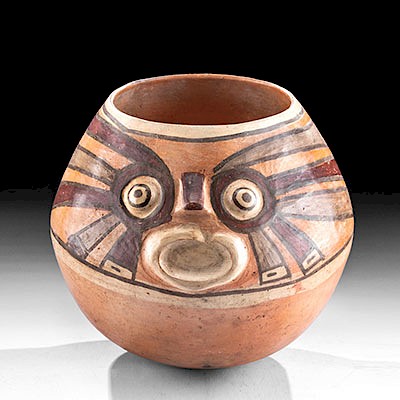Greek 20K+ Gold Bracelet w/ Lion Headed Clasp
Lot 19c
About Seller
Artemis Gallery
686 S Taylor Ave, Ste 106
Louisville, CO 80027
United States
Selling antiquities, ancient and ethnographic art online since 1993, Artemis Gallery specializes in Classical Antiquities (Egyptian, Greek, Roman, Near Eastern), Asian, Pre-Columbian, African / Tribal / Oceanographic art. Our extensive inventory includes pottery, stone, metal, wood, glass and textil...Read more
Categories
Estimate:
$5,000 - $7,500
Absentee vs Live bid
Two ways to bid:
- Leave a max absentee bid and the platform will bid on your behalf up to your maximum bid during the live auction.
- Bid live during the auction and your bids will be submitted real-time to the auctioneer.
Bid Increments
| Price | Bid Increment |
|---|---|
| $0 | $25 |
| $300 | $50 |
| $1,000 | $100 |
| $2,000 | $250 |
| $5,000 | $500 |
| $10,000 | $1,000 |
| $20,000 | $2,500 |
| $50,000 | $5,000 |
| $100,000 | $10,000 |
| $200,000 | $20,000 |
About Auction
By Artemis Gallery
Dec 5, 2019
Set Reminder
2019-12-05 10:00:00
2019-12-05 10:00:00
America/New_York
Bidsquare
Bidsquare : Ancient / Ethnographic - Holiday Edition
https://www.bidsquare.com/auctions/artemis-gallery/ancient-ethnographic---holiday-edition-4710
What to give this holiday season? Ancient & Ethnographic Art of course! Our special Holiday auction features hundreds of unique finds from all over the world. Artemis Gallery info@artemisgallery.com
What to give this holiday season? Ancient & Ethnographic Art of course! Our special Holiday auction features hundreds of unique finds from all over the world. Artemis Gallery info@artemisgallery.com
- Lot Description
Ancient Greece, Hellenistic, ca. 3rd to 2nd century BCE. A gorgeous gold bracelet that glistens like sunlight (88% gold, equivalent to 20K+) replete with impressive artistry and symbolic iconography. The piece is comprised of four gold wires - two that are smooth and two that present a 'beaded' pattern - carefully woven and twisted in a helical manner and resolving in two handsome lion head terminals and presenting fabulous detailing of the wild felines' features in bas relief, followed by short cylindrical collars adorned by beaded bands where the twisted wires meet the heads. One of the lions has wire extension that hooks into the other lion terminal - the artisan of this piece clearly demonstrated great ingenuity as well as style. Weight: 13.5 grams. Size: 8" L (20.3 cm) circumference; opening is 2" in diameter (5.1 cm); lion terminals .625" L x .375" W (1.6 cm x 1 cm)
Lions are often the stars of ancient Greek stories, such as Herakles' defeat of the Nemean lion. In ancient Greece, lions symbolized both strength and royalty. This said, in addition to being depicted for their symbolic meaning, it is also probable that the creator of this piece saw lions in real life. Aristotle and Herodotus tell us that lions lived in the Balkans and Greece until around the 1st century BCE!
This piece will be accompanied by a digital copy of a Striptwist Ltd (London) report by Dr. Jack Ogden attesting to its ancient origin. Ogden mentions that there may have been another component within the spiraled wires, likely glass. He writes, "Hellenistic jewellery with glass components of this type is known, but glass does not always survive the passage of time intact. We also find similar hoops in hard stones such as rock crystal, but this is unlikely here as rock crystal will not decay and would have left fragments in place even if broken in antiquity." He also notes that all the gold components were hammered sheet gold or wire rather than cast. He describes, "The heads are of sheet gold with delicate chasing for the details. A wire extends from under one head and forms a hook which locates into a hole below the jaw of the other lion head as can be seen in the photo right. This fastening hole is bordered with beaded wire, like that on the two collars. The hoop consists of four coiling wires, two plain round wires, the other two beaded wires. The plain wires, as shown upper right, are made by what is termed the strip twist technique, the usual method of gold wire making prior to Medieval times. A narrow strip of gold sheet was twisted along its length and then rolled between two flat surfaces. This produced a good wire of even, circular cross section, but retaining, to a greater or lesser extent, the spiral seam lines as seen faintly here. Beaded wires were made by rolling a circular-section wire under a tool with two edges. Beaded wire became popular in the seventh century AD and is often seen in Hellenistic goldwork. It largely died out after about the tenth century AD. The coiling plain and beaded wires are attached to the terminals by passing them through small holes and then bending back... This unsophisticated type of attachment was necessary because soldering could not be used if there was a glass hoop in place – the heat would destroy the glass. This type of mechanical joint is common in much Hellenistic Greek gold jewellery where at least part of the assembly had to follow the incorporation of materials that would be affected by heat – such as glass, gems and enamels."
Provenance: private East Coast, USA collection; ex-Frances Artuner collection, Belgium, collected in the 1960s
All items legal to buy/sell under U.S. Statute covering cultural patrimony Code 2600, CHAPTER 14, and are guaranteed to be as described or your money back.
A Certificate of Authenticity will accompany all winning bids.
We ship worldwide and handle all shipping in-house for your convenience.
#148394Lion terminals have some surface deposits, and their forms show slight age wear with minute indentations and cracks, but are otherwise nicely preserved and show great details. The bracelet may have held a glass core at one time, as suggested in the Striptwist report.Condition
- Shipping Info
-
All shipping is handled in-house for your convenience. Your invoice from Artemis Gallery will include shipping calculation instructions. If in doubt, please inquire BEFORE bidding for estimated shipping costs for individual items.
-
- Buyer's Premium



 EUR
EUR CAD
CAD AUD
AUD GBP
GBP MXN
MXN HKD
HKD CNY
CNY MYR
MYR SEK
SEK SGD
SGD CHF
CHF THB
THB














